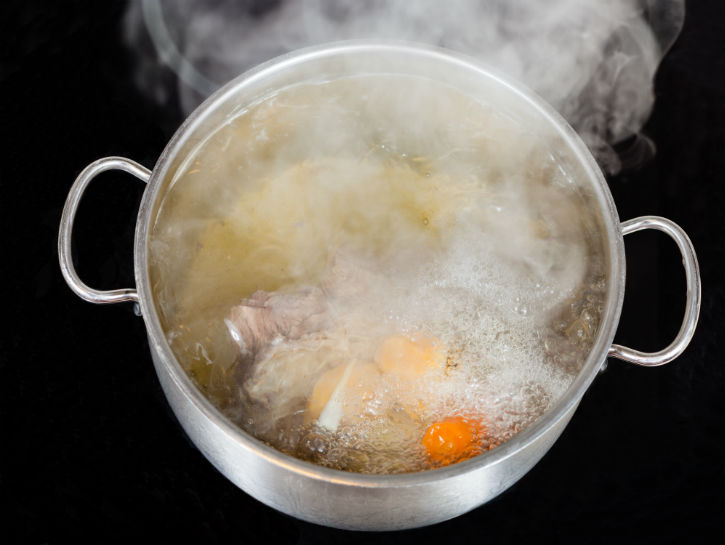Beef stock is an important part of everyday cuisine — it allows you to make stews and soups, it serves as a braising liquid and it’s the basis for many sauces in cooking. Beef stock also allows you to make use of leftover vegetables and beef scraps that you have from other meals. Making beef stock at home is a relatively simple process but you need to have the right tools and you need to have patience. It’s worth taking the proper steps to ensure your beef stock comes out well, as it can make or break many of your dishes.
What You Need To Make Beef Stock

Beef stock requires a large amount of water to be reduced, so if you want to get a sizeable yield, it’s recommended to get have a stainless steel pot that can hold at least 12 quarts. Your final third will be between one half and one-third of the original amount.
- 3-4 pounds of beef “scraps” — this can be anything from the fat trimmed off beef steaks or roasts to leftover bones. Bones are recommended because their marrow gives the stock some great flavor. If you don’t have many scraps, use stewing beef to cover the rest of the weight.
- 2 medium onions
- 2 large carrots
- 2 celery stalks
- 4 garlic cloves
- ½ bunch of parsley
- ½ bunch of rosemary
- 3 bay leaves
- 2 tablespoons whole peppercorns
- Olive oil
How To Make Beef Stock

- Toss all of your beef scraps in some olive oil and evenly spread them across a baking sheet. If you need to use multiple sheets, that’s fine!
- Preheat your oven to 400 degrees. Once it’s reached the set heat, place your baking sheets in the oven and roast for about 30-40 minutes. If using multiple baking sheets, be sure to rotate them halfway through the roasting time. You want to get a nice brown color on the meat but be careful not to burn it.
- When finished, remove the sheets from the oven and place in the stockpot. Use some hot water to scrape the bits of meat stuck to the sheets and then dump those bits into the pot as well.
- Roughly chop your onions, carrots, and celery into one to two-inch pieces. Place them in the pot and add the garlic, parsley, rosemary, bay leaves and whole peppercorns.
- Place your pot on the stove and fill the stock pot with cold water. You want the water level to be a couple of inches above the bones in your stock pot.
- Turn the heat on high and bring the pot to a low simmer and then put the heat on low. You don’t want the stock to come to a boil, you want it on a low heat with just a couple of bubbles popping up here and there. Once you have it at the ideal temperature, let it sit for 6 to 8 hours.
- Do not stir the stock during this time — as it simmers, fat from the meat will rise to the top. Periodically check the stock and with a large metal spoon, scoop out the fat that’s sitting at the top of the stock (you’ll notice an oily-looking substance). Make sure to place the fat in a jar to safely dispose of it later, as pouring this fat down the drain will risk clogging your pipes.

- At the end of the cooking time (or until the stock has been reduced to about a third of its original amount), use a pair of tongs or a large slotted spoon to remove the big chunks of meat and veggies from the stock and throw them in the garbage. After that, place a very fine strainer over a smaller pot and pour the stock into the smaller pot to strain the stock of the remaining chunks.
- Let the stock cool to room temperature and then place it in the fridge. Once the stock has sufficiently chilled, you can remove the rest of the fat that has risen to the top with ease, as it will have solidified.
- Portion your stock into liter containers or jars and store in the fridge!
Tips And Tricks For The Best Beef Stock

There are a few things worth noting when making beef stock to make sure it comes out as wonderful as possible.
Low And Slow
The longer you have the beef stock on a low heat, the more flavorful it will come out. If you don’t have time, you can crank the heat slightly and have a stock done in about three hours, but a very low simmer for six to eight hours will leave you with the best possible stock.
Watch What Vegetables You Put In
Aromatic vegetables such as onions, carrots, garlic and various herbs are all necessary for a good stock. You can add lemongrass to give your stock another level of flavor. Never put any bell peppers or chilis in a stock and avoid putting tomatoes in while making the stock — save them for braising.
Bones Make The Difference
While you can make a beef stock just off meat scraps and stewing beef, the bones are what make it a standout stock. Saving the bone scraps from steaks and ribs will allow you to extract the marrow, making for a rich, flavorful stock. Combine this with a prolonged low cooking time and you’ll have as close to the perfect stock as you can get.
